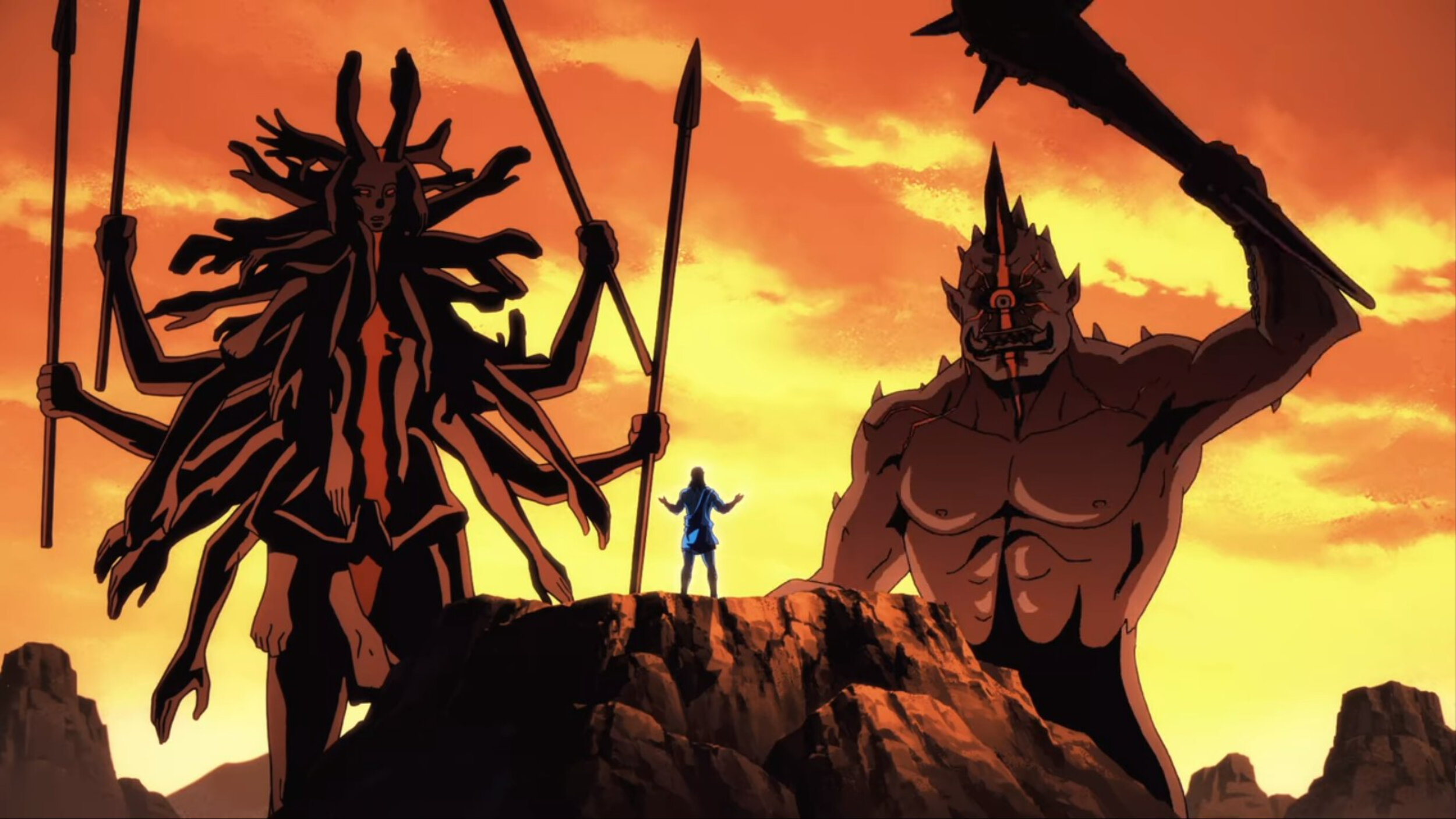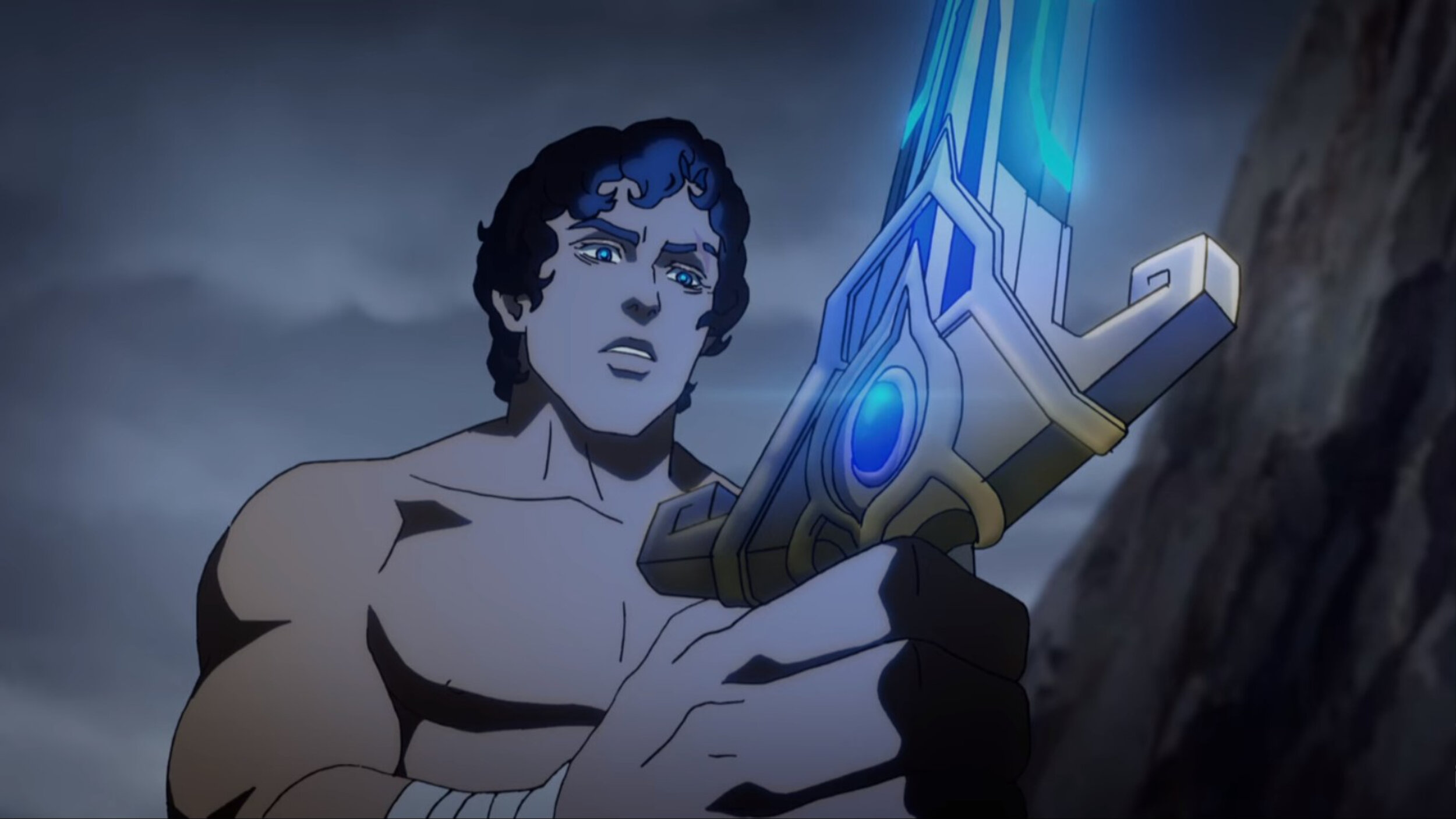Mythologies Old and New: Netflix’s Blood of Zeus
Blood of Zeus (2020-present) is the brain child of Charley and Vlas Parlapanides, two Greek-American screenwriters best known for their work on the 2011 film Immortals, a live-action fantasy adventure loosely inspired by Greek mythology. This time, the brothers have teamed up with Netflix and Powerhouse Animation Studio to create an animated epic drama series, also set in mythical Greece, which follows the evolution of young Heron, a good-hearted outcast who, upon learning that he is the son of Zeus, steps into his father’s footsteps and becomes a powerful warrior. His quest is to drive out the demon scourge that has come upon Greece, but it turns out that the leader of that demon scourge, a youth named Seraphim, happens to be his mortal brother from whom he was separated in infancy and who became a demon by ingesting the remains of the vanquished Giants. We watch as the brothers, used as pawns by Zeus and Hera in their own vengeful battle for dominance over each other and over the world, take divergent paths and come to understand fully the influence of the gods on their past and present lives.
Blood of Zeus (2020-) - Official Trailer.
The show has been a success, landing on Netflix’s global and US top 10 lists for its first week on the platform and earning a score of 100% on the Rotten Tomatoes’ Tomatometer (Francisco 2020). Recently, the show has been picked up for a second season by Netflix, and the Parlapanides brothers have said they have five seasons outlined (Katz 2020). This success is due in great part to the eye-catching design and cinematic action sequences created by Powerhouse, a group which had already established its bona fides for Netflix with its production of Castlevania in 2017, now beginning its fourth season. Powerhouse has once again done an excellent job of striking a balance in creating a vehicle that draws upon Japanese anime for inspiration while at the same time retaining features recognizable from American superhero comics and cartoons (albeit with Zeus leading the ensemble instead of Iron Man). This hybrid, West-meets-East quality extends to Blood of Zeus’s visual aesthetic as well as its narrative composition, and has enabled it to capture the interest of a diverse and international fan base.
In its eight episodes, the show engages extensively (and violently) with several strands of ancient mythology, though at the outset it is made clear that this is being posited as a “lost” tale from the Greek oral tradition, which allows for a great deal of freedom and deviation from the canonical stories. The story of Heron, the main protagonist, shares many traits with that of Greece’s best-known hero, Hercules, another son of Zeus who was born with a non-divine twin brother and who ultimately became a god. While depicted in a more sympathetic manner than in traditional myth, the wrath of Hera and her unceasing jealousy over Zeus’ infidelities is, perhaps somewhat too predictably, a central driver of the show’s plot. The Gigantomachy, or battle between a primordial race of Giants and the Olympian gods, is also invoked at the outset of the show and provides its primary backstory. Gods like Hermes, Apollo, and Hephaestus, while not receiving a lot of attention in their own right, display the features we would expect them to, though they are rendered in innovative ways: Hephaestus is a steampunk, for example, and Apollo has a surfer vibe about him. Similarly, non-divine characters like Alexia the Amazon warrior and Chiron the wise Centaur each conform to their mythical precedents, and the Underworld is just as gloomy and gruesome as one would expect.
However, there is just as much (if not more) of what could be termed “new” mythology incorporated into this supposedly ancient tale. For example, Seraphim and his fellow flesh-eating demons draw upon a rich store of current references, from Game of Thrones’ (2011-2019) White Walkers to the yokai subgenre of anime (Perkins 2019). Also, much like in the wildly-popular anime franchise Demon Slayer: Kimetsu no Yaiba (2016-2020) or the slightly older Inuyasha (1996-2008), demons and their relationships with humans are portrayed in a complex and sometimes compassionate light. There are nods to kaiju movies and Godzilla in the depiction of the Giants (Fig. 1), and in the battle royale they take part in at the end of the season, while Avengers: Endgame (2019) has also been acknowledged as an influence in this context by the Parlapanides brothers (Zacharia 2020). References to Star Wars abound throughout the series, in everything from the shimmering adamantine sword forged for Heron by Zeus (Fig. 2) and the focus on their evolving father/son relationship, to Chiron’s betrayal of Alexia in Episode 5, which directly quotes Lando Calrissian when Han Solo learns of his betrayal in The Empire Strikes Back (Lehmann 2020). Finally, Hera’s characterization as a jealous femme fatale in the mold of the Evil Queen from Snow White and the Seven Dwarfs (David Hand, 1937), specifically her use of a magic mirror in Episode 2, is another striking allusion, this time to the myth-world of Disney. And while the goddess does not go as far as to transform herself into an old hag like the queen, her accompaniment by a murder of crows and her use of the Cauldron of Darkness certainly recall that figure’s powers of witchcraft.
All of these pop cultural references are clearly meant to engage the audience by presenting tropes that are familiar and by evoking a sense of satisfaction in those who can spot them. But sometimes, like the many-stranded webs spun by the Fates for Heron in Episode 6, the interweaving of these various threads of modern myths threaten to overwhelm Blood of Zeus’ main narrative. The layers of subtext they create impede its forward motion rather than advancing it, especially in the first half of the series, where flashbacks play a prominent role. Flashbacks are a tried-and-true element of ancient epic storytelling, so it is no surprise that we encounter them as the background stories of the gods and Giants, Heron’s birth, and Seraphim’s descent into darkness are laid out (Alden 2017, 1-15). These expository moments, which are important for the show’s world-building and for understanding the characters’ motivations, are frequently the moments where these “new” mythologies are most thoroughly explored. But they crowd out Heron’s “real-time” trials and tribulations to the point where it takes some reminding to recall where things stand for him and his quest to save Greece from the invading demon army (Fig. 3).
It also means that other – seemingly important – characters are left undeveloped while those who are even more peripheral, like Heron’s trusty sidekicks, Kofi and Evios, and even some of the gods, seem almost tacked on. The most glaring example of this is Alexia the Amazon, who seems central to the story as a demon slayer and traditional warner figure, but by the end of the series, it is still unclear who she really is and why she is so involved in Heron’s story (we do get a tease of her backstory as she crosses the Fields of the Dead in Episode 7, though it offers more questions than answers). The expectation that these characters’ stories will be fleshed out in the second season of the show is made abundantly clear throughout the series, and hopefully that will be the case. The last two episodes, which feature the big battle between the Olympian gods and the Giants, while the most spectacular and compelling of the series, also leaves the audience with lots of big questions, in particular the question of what exactly happened to Zeus in the end; it even forces us to ask the question of whether a god can die (Ellwood 2020).
One final observation that is related to the character of Alexia is about the portrayal of female characters in the Blood of Zeus in general, which hews pretty closely to the traditional roles of mothers and wives we encounter in film and TV. Even Alexia, who ostensibly does not fit this profile at all, works in service of the male character Heron for reasons, as noted above, that aren’t wholly clear. There’s some suggestion that a romantic element to their relationship is developing, but that still doesn’t explain why she has allied herself to him. On the divine level, Hera’s stereotypical portrayal as a wicked stepmother makes watching the dysfunctional family dynamics play out between her and Zeus’ bastard sons that much more enjoyable, but it is important to point out that, at least in Season One, there have been no other female deities (aside the Fates’ brief appearance) who played any active role or had speaking parts. Clearly this is a manifestation of reactionary sexism, itself born out of yet another type of mythology that is grounded in conventional pop cultural depictions of women, and it possibly points to an assumption (by Netflix, the show’s producers, and/or by the Parlapanides brothers themselves) of an equally-reactionary, younger, and mostly male demographic who are presumed to have cut their teeth on older comics and anime that carry such depictions as a form of cultural currency. Nonetheless, it is a characterisation of women, and an omission of modern ideas and sensibilities, that – hopefully – will be rectified in Season Two, and which will, in its acknowledgement that its audience is more diverse than such characterisations presume, ideally make Blood of Zeus even more fun and dynamic than it has already proven to be.
**Article published: April 23, 2021**
References
Alden, Maureen. 2017. Para-narratives in the Odyssey: Stories in the Frame. London: Oxford.
Ellwood, Tara. 2020. “Blood of Zeus Ending & Season Two Setup Explained.” Screen Rant, October 29, 2020. https://screenrant.com/blood-zeus-ending-heron-hades-season-2-setup-explained/.
Francisco, Eric. 2020. “’We Couldn’t Even Get a Meeting’: How Blood of Zeus Became a Netflix Hit.” Inverse, November 5, 2020. https://www.inverse.com/entertainment/blood-of-zeus-showrunners-interview-charley-vlas-parlapanides-anime-netflix.
Katz, Brandon. 2020. “Blood of Zeus Creators Aim for 5 Seasons, but That’s Not Netflix’s Style.” Observer, November 3, 2020. https://observer.com/2020/11/netflix-blood-of-zeus-renew-cancel-ratings-viewership-cost/.
Lehmann, Christian. 2020. “Blood of Zeus, Episodes 5-9: Mythographers Discuss.” November 9, 2020. https://youtu.be/pSFMv3Ex6U
Perkins, Chris. 2019. “Gods and Monsters: The Weird World of Japanese Yokai.” Animation for Adults, October 29, 2019. https://www.animationforadults.com/2019/10/gods-and-monsters-weird-world-of.html.
Zacharia, Katerina. 2020. “Creativity and Collaboration: A Conversation with Blood of Zeus Creators Charley & Vlas Parlapanides.” November 23, 2020. https://youtu.be/YiQkvEpGzwE.
Biography
Chiara Sulprizio is a Senior Lecturer in the Department of Classical and Mediterranean Studies at Vanderbilt University. She is interested in the reception of the Classical past in modern comics, graphic novels and animation, and she is the creator of the web archive, Animated Antiquity, which features video clips and original commentary on animated representations of ancient Greece and Rome (www.animatedantiquity.com). She contributed an essay to the 2011 collection, Classics and Comics, on the Trojan War-themed graphic novel Age of Bronze, and she recently published an essay in the online journal Antiquipop on animated representations of Homer's Iliad. Twitter: @chiarasulprizio / Facebook: @animatedantiquity.



